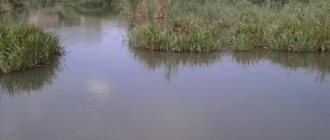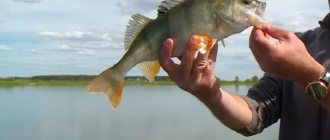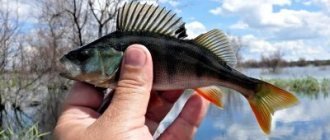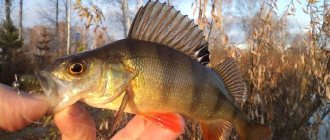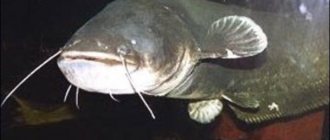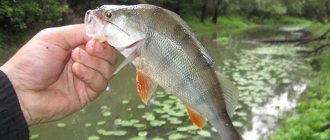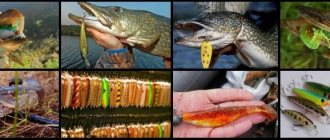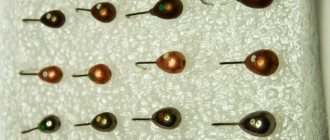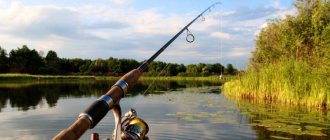Perch in September
Small perch, weighing up to 300 grams, is found throughout the reservoir at different depths. Such individuals are usually caught for use as live bait. A small striped predator is often caught on a hook as a passing catch when fishing for crucian carp, large roach, etc. In small ponds and lakes, perch rarely gains a weight of more than 300 grams.
Large perch are active in September, but they do not rush around the reservoir in all water levels. It moves in bottom depressions, and often ambushes behind snags and other underwater obstacles. On large and medium-sized rivers, the predator hunts away from the channel flow. A good sign of the presence of a perch are found edges, coastal cliffs or steep drop-offs.
Successful perch fishing in September is possible from dawn to dusk. The frequency of biting depends on the size of the detected flock. In places where the food supply is concentrated, perches can linger for more than 30 minutes. This is also facilitated by attractive bait for perch. The use of complementary foods depends on the fishing methods.
Features of catching perch in late autumn
Autumn is an ambiguous time - some people like it, others find it irritating.
However, for any angler, especially for those who are interested in spinning, autumn is a long-awaited time. It is during this period, especially in late autumn, that the probability of catching a real trophy is highest. Perch fishing in late autumn
can be not only rich in catches, but also rewarding with large trophies.
Of course, in the fall, pike is primarily caught, and most anglers target the toothy predator, but autumn perch fishing
also has many fans. Both pike perch and catfish are caught well in the fall, and from October you can catch burbot. And even such semi-predatory fish as ide and chub can be caught on small spinning baits.
And if you use light and ultra-light spinning rods, then fishing in the fall can be made even more exciting and vibrant. Catching autumn perch with ultralight
interesting and exciting, full of bright events and surprises. It is perch that can become the main prey if, due to some circumstances, fishing for pike perch or pike does not produce results. Moreover, there are much more places where you can catch a striped robber than places where you can catch pike and pike perch. Autumn perch can actively bite in the river, in the lake, in peat bogs and even in a small pond.
The conversation will mainly focus on catching perch in late autumn. Many fishermen in late autumn purposefully catch only perch, especially if it is large in size. Observant fishermen in the autumn, after several forays into reservoirs, determine the tactics and methods of catching perch and use them successfully.
Nowadays, when winters have become quite mild, late autumn can last until the second half of December; perch fishing lasts until the freeze-up begins. And this time period has increased significantly. Most often, fishing for autumn perch is done using the jig method; less often this predator is caught with a spoon or wobbler. The thing is that in late autumn it is difficult to seduce perch with wobblers and spoons. And in this situation, all the advantages of silicone and foam rubber are obvious, which are significantly superior to plastic and metal baits in terms of catchability. Moreover, these baits are not able to compete with edible rubber in late autumn. It is difficult to dispute such a factor. However, it is quite possible that someone has their own views and their own approach to this topic, but still the main topic will remain jig.
Knowing how perch behaves in the fall, its permanent locations, hunting areas and food preferences in late autumn, allows the spinning angler to select the necessary baits and leads, and mount the equipment correctly. However, we must take into account that in November and December. Perch is distinguished by its unpredictability, and it is almost impossible to predict, let alone predict, how a striped fish will behave. Therefore, autumn perch fishing
full of surprises and surprises. The behavior and activity of perch can change many times during the day. It is very difficult to specifically understand, and even more so to explain, what factors influence the activity of the striped fish; there are a lot of them, and they can depend on a variety of situations. Sometimes it happens that in a day of fishing you can catch a dozen tails using edible rubber using the slowest retrieve. The next day you can catch a striped fish in a minute, not even with an edible fish, but with a regular vibrotail or twister.
However, perch fishing in November
the most athletic, since this predator generally leads an inactive lifestyle, and bursts of activity occur only periodically and do not last long. He sometimes becomes hyperactive and can even make his famous “cauldrons”. This activity does not last long, maybe a few tens of minutes, maybe an hour, and it is similar to the activity that the striped whale shows in the summer at dawn.
In this case, the conclusions are simple - in late autumn, good results can be achieved by those methods and baits that can activate an inactive predator. However, when there is a surge in activity and the perch begins to have a short-term hunger, even ordinary silicone can show excellent results.
It is a monolithic jig head with a regular twister or vibrotail that will work best. Hungry perch really like these types of baits, and the cast should occur either at a medium or fast pace. Also, the standard equipment is easy to remove from the predator’s mouth. After all, a perch, attacking an active bait, is most often hooked by the lip.
There are several other methods and baits for catching passive perch. The method of fishing in this case is, first of all, delicate retrieval of the bait. A passive striped one does not rush in pursuit of silicone moving at high speed. However, if the fishing speed is reduced to a minimum, it becomes easy prey for the perch, and naturally provokes it to attack.
It is best to use passive baits made of edible rubber for slow retrieving. Of course, some spinning anglers also use regular twisters or vibrating tails, and sometimes they can even seduce an inactive perch, and sometimes even get good results in this case. However, edible rubber is in any case much more effective. The very possibility of effective fishing during pauses is attractive here.
The most successful perch fishing in late autumn
, this is exactly what happens during pauses, when the bait stops and then lies on the bottom and becomes motionless.
The predator, attracted by the movement of the bait, tastes it and, finding out that it meets his tastes, swallows it. The best passive baits are slugs, crustaceans and worms made of edible rubber, for catching perch weighing more than 120 g. And it is better to catch small things using cutting. But this is not always an inviolable rule. Sometimes fishing for perch in late autumn
can be more effective with active baits, however, also made of edible silicone. However, even in this case, the perch grabs the bait after it falls to the bottom. And quite rarely a striped attack occurs when the bait falls freely.
Happy fishing!
Perch in October
The weather in mid-autumn is characterized by its variability. On rainy, cloudy days with gusts of wind, perch fishing in October is unpromising. Relatively warm days and stable atmospheric pressure are excellent conditions for perch fishing. A slight breeze is not a problem.
Anticipating the onset of cold weather, the predator actively feeds. Small fish often focus on the depths, and perch usually move behind them. From the second half of the month there is a cooling, and the number of perch schools increases. This is the best period for catching perch in the fall. In October, perch bites on artificial baits and bait of animal origin.
Casts are made to a depth of over 2 meters under coastal thickets or depressions near reed islands. It is advisable to choose areas on the leeward side. In October, perch often enters river bays and deep reservoirs connected to the main channel. You should not ignore the bends of the riverbed, into which the current carries a large number of zooplankton representatives. It is the main food for perch weighing up to 800 grams.
Perch in November
After stable night frosts, perch gradually moves to depth in November. In bottom depressions, fish will experience a period of freezing. During the cold season, the activity of the predator decreases, but it continues to search for food even after the reservoir is covered with ice. Perch fishing begins in winter from the ice.
The food supply for perch decreases in November. Bottom-dwelling organisms and some species of peaceful fish burrow into the mud for the winter. The main prey of large perch are active small fish that do not go into suspended animation in cold water.
Compound
Bait for perch should contain:
- The basis. It is represented by dry white clay, crushed eggshells, soil, oatmeal, bran, corn or shrimp flour and breadcrumbs. It is advisable to use white bread.
- Feed base in the form of various animal components.
- Supplements Fishermen season the mixture with cake, sunflower or hemp seeds, aromatic oils, attractants and bite activators.
- Water.
According to experts, the best bait for perch is the one prepared the day before. Mostly large individuals react to it. For small and medium-sized fish, bait mixtures are prepared directly on the spot, on the shore of the reservoir.
Each of the components performs a specific function. Abundant turbidity is created due to the presence of dry blood, milk powder and daphnia in the bait. The friability of the mixture is given by river sand, worms, bloodworms and maggots. Clay is suitable as a cementitious substance. This goal is also achieved with oatmeal and egg powder.
Perch tackle
For autumn fishing, all perch gear used when catching this predator during the period of open water is applicable. List and equipment of gear used for perch fishing:
- Spinning. Fans of active fishing prefer spinning rods. Perch can be caught with a spinning rod from the shore and from a boat. For comfortable fishing, it is important to choose the right elements of gear and equip the spinning rod.
When choosing a spinning rod for perch, you need to pay attention to its length, test and action. The length of the rod should ensure convenient casting of the bait to the perch in specific fishing conditions. The optimal option is 2.4 m. A spinning rod of this length is excellent for fishing from the shore and boat. Test within 5 - 15 grams. For timely hooking and retrieving, a rod model with a medium action is suitable.
Inertialess reels are very popular. But you shouldn’t ignore high-quality inertial coils. The type of reel is selected at the request of the spinner.
To catch perch, a spinning rod is equipped with a fishing line or cord. When choosing a fishing line or cord for a spinning rod, you need to focus on the load capacity. The equipment for perch must withstand a tensile load of at least 5 kg.
If there is a pike in the pond, then it is better to play it safe and install a metalized leash. The toothy predator is often tempted by baits designed for catching perch;
- Float rod. A Bologna fishing rod with a rod length from 2.7 m to 6 m is excellent for catching perch. The length of the rod depends on the fishing conditions. Supporters of fly rods or match rods do not change their habits when specifically fishing for perch.
Fishing for perch with a float rod is carried out with traditional bait or used as live bait. Single hooks of sizes 3.0 – 4.0 according to domestic numbering are applicable. Doubles or tees are installed on live bait equipment. With their help, the bait is correctly mounted, ensuring its mobility until the predator bites. The “freedom” of movement of live bait is limited by a leash 30-50 cm long.
Something to remember! Regardless of the type of gear, the diameter of the leader should be 10% less than the diameter of the main line.
Retention of live bait in the bottom layer of water is ensured by tying a sinker, under the weight of which the float is loaded;
- Mugs for perch. On large rivers, large lakes and reservoirs, fishing for perch with mugs is used. The fishing is the same as fishing for pike with mugs;
- Summer girders. Summer girders are successfully used for catching perch from the shore. These live bait gear are used when dumps or cliffs are found in the coastal zone.
DIY carp bait recipes
When going fishing for carp, do not forget to provide bait for the fish. You can buy it at a fishing store or prepare it yourself. If you decide to buy ready-made complementary foods, it is better to purchase treats from well-known brands - the quality will be guaranteed. Well, if you decide to prepare complementary foods yourself, in this issue of our online magazine you will find useful tips and recipes for the most catchy baits.
How to make bait for carp at home
So, if you buy complementary foods, everything is quite simple.
But if you still decide to make a fish delicacy at home, there are several rules that will allow you to catch the largest carp. Since this is a large fish, in order to attract it to the fishing site, you need to prepare complementary food from large pieces so that it can swallow them. Corn, peas, potatoes, pea puree, mixed feed and other cereals are suitable for complementary feeding. To enhance the taste, add powdered milk and/or fish meal to the complementary food, which you can buy at a fishing store or prepare yourself. This is not difficult to do; you just need to dry the fish and grind it into powder. Now let's take a closer look at the main components that make up complementary foods:
- Bulk (base) mixtures. This can be powdered milk, fish meal, bread crumbs, as well as various additives that can be purchased at a specialty store. These mixtures have a small caliber, and when thrown out at the feeding site, they create a fragrant cloudy cloud, which the carp comes to with great pleasure.
- Grain mixtures. This group includes cereals and bran. The queen of grain mixtures is corn, but it must be used with great caution, since feeding with corn can have the opposite effect - the carp simply will not approach the feeding area. Too much corn smell can scare off very wary carp. But hemp, on the contrary, can be used in unlimited quantities. After all, hemp grains contain a large amount of vitamins and amino acids, so hemp is a favorite treat not only for carp, but also for a number of other fish.
- Pellets (pellets) or granules. They contain a lot of fat, and due to the long breakdown in water, all the goodies of the pellets spread through the water for a long time. These components can be used as independent complementary foods or in combination with other components. Sometimes pellets are replaced with cat or dog food in the form of granules.
- Live food. To add a special taste, so-called live food is added to complementary foods - these are worms, bloodworms, and maggots. All these animals can be used as independent complementary foods; they can be added to the mixture either whole or in pieces.
- Boilies are a type of bait attached to a hook. The composition of boilie is varied - it includes starch, fish meal, cereals, flavors, dyes, flavorings and other “tasty” components. Boilies can also be used as complementary food. This bait must be filled with water and salted well, but not over-salted, otherwise the fish will not eat it. Boilies are divided into dissolving (otherwise dusty) and non-dissolving (boiled), sinking (pop) and floating (ap), round (regular) and cylindrical (dumbles). By the way, boilie baits for carp can also be prepared with your own hands - read about this in the issue of our online magazine.
- Nuts. This is a very heavy bait for fish, but if you add it in the right proportions, the delicacy acquires an unusual taste, which further lures the fish.
- Fruit additives. These are supplements consisting of natural fruits, cut or grated. Sometimes fruit trees grow near a pond, and overripe fruits fall into the water, creating a cloudy cloud. The carp swims to this place, and its usual delicacy is those fruits that grow on the shore.
Recipes for preparing bait for carp
To make your fishing successful, we offer you several detailed recipes for making carp bait with your own hands.
Mix all the ingredients and leave for 10-15 minutes so that all components are saturated with each other’s scent.
Take in equal proportions:
- peas;
- millet;
- pearl barley
Add water and cook the porridge. Stir during cooking to prevent burning. After the porridge is cooked, add unrefined vegetable oil to enhance the smell, 2 tbsp. spoons of honey, breadcrumbs (their quantity should be 1/5 of the total mass) and cake (1/10 of the total mass). Let it brew for 30 minutes, and the bait is ready.
Mix:
- ground cereals (total weight 2 kg);
- 200 g cake;
- 400 g milk powder;
- 400 g cat or dog granular food;
- 8 crushed boilies (necessarily sinking);
- crushed worms, maggots or bloodworms (1/20 of the total mass);
- 2 tbsp. spoons of honey;
- 300 g boiled or canned corn or peas.
Cook porridge from the cereals, add all the remaining ingredients, mix thoroughly and let sit for 10-20 minutes.
- 400 g pearl barley;
- 400 g corn grits;
- 400 g breadcrumbs;
- 300 g boiled or canned corn or peas;
- 2 tbsp. spoons of honey;
- 2 tbsp. tablespoons unrefined vegetable oil;
- 100 g of ground or crushed fruit from a tree growing on the shore of a pond.
Cook porridge from the cereal, add butter, honey and let cool. Once the mixture has cooled, add the remaining ingredients and stir thoroughly. Leave to sit for 15 minutes. The bait is ready.
In addition to the described recipes, we suggest watching a video, the author of which also prepares bait for carp with his own hands and demonstrates it in action:
Flavorings in carp baits
When preparing complementary foods, do not forget to add such an important component as flavorings.
Flavors can also be purchased at a fishing store and can be made with your own hands. A separate issue of our online magazine is devoted to the issue of making your own flavorings. There are several types of flavorings loved by fish:
- Liquid flavors. They can be applied as a spray, drops, and there are also those in which you can simply dip the bait.
- Powdered flavors. Such flavorings are most often used to make boilies.
Liquid flavorings are often used to feed carp. The favorite smells of carp are:
The aromas listed above are suitable for the warm season; for the cold season it is better to use the following aromas:
How to choose and use bait for fishing
The choice of bait in each individual case is influenced by a number of factors, which we will consider below.
The composition of complementary foods directly depends on the time of year. Thus, during the cold season, carp prefers protein foods, so when going fishing in the fall or winter, prepare complementary food rich in maggots, bloodworms, worms and containing less flavorings than usual. Read more about catching and feeding carp in the fall in a special issue of our magazine.
If you are going fishing in the summer or spring and prepare bait for carp with your own hands, you can slightly change the traditional recipe and add more flavors. In warm weather, the activity of carp increases, and it is more willing to go to the feeding site.
Many fishermen note an amazing fact: if you add boiled potatoes to the bait directly during a thunderstorm, the carp will swim much faster. At the same time, you can experiment with bait - also add potatoes. Remember that the potatoes should be slightly undercooked so that they do not fall apart when hooked.
Carps prefer bodies of water with standing water or weak currents. If there is a current in the fishing area, place the feeding area as close as possible to the bait site. To do this, you need to add a binder to the bait, for example, corn or wheat flour, and throw balls that fit in your palm into the water. Just take a handful of baby food and form it into a ball. This is necessary so that the bait begins to disintegrate in the water, and not in flight.
Before pouring in the complementary foods, stir up the water, and then throw in the complementary foods. This is done in order to attract carp, because the smell spreads through the water; carp instinctively knows that where it is muddy, there is always something to eat.
If the bottom of the reservoir is abundantly covered with algae, then for the best effect, in addition to dry milk, breadcrumbs and other “turbid” components, you need to add crumbly cake and/or bran to the bait, which, when floating, will attract fish from the middle and upper layers of the reservoir. Also, when making bait for ponds with an overgrown bottom, add more flavorings - this will help lure out the fish hiding in the holes.
Carp is a fish that eats constantly. There are no restrictions on the amount of food; the main thing is to feed evenly in the area where you are fishing. It is better to prepare complementary foods in excess than in shortage - the fish should be as interested as possible.
Don’t forget that carp mainly live in depressions at the bottom of reservoirs. To lure it out, simply add more flavors to the bait.
Common mistakes when feeding carp
- Lack of bait ingredient in complementary feeding. If you use corn, peas, worms or other components as bait, they must be included in the complementary food. This way you will be able to deceive the fish, and it will get hooked.
- Excessive amount of flavoring in complementary food for carp in winter. Too strong a smell will scare off carp, whose activity is very low during the cold period.
- One-time feeding. Carp need to be fed almost constantly. As soon as you notice that the intensity of the bite has subsided, urgently feed the fish. This will not only keep the fish that are near you, but also attract new individuals.
- Inattention to the flow. When feeding complementary foods in a pond with non-stagnant water, take into account the current. The bait should be in close proximity to the bait.
In the previous article, I told you about the features of float fishing in the summer. Now it’s time to find out what float fishing is like in the fall, where to look for fish at this time, how to lure it, and what gear and bait you need to use so that fishing with a float rod in the fall is a success.
Float fishing in autumn, habits of aquatic inhabitants and their search
Autumn is an excellent time for fishing for roach, carp, ide, bream, bleak and you have a good chance of catching trophy fish. The best bite can be expected during the “Indian summer”, when there are warm, fine days and a gentle wind blowing. Now her habits and behavior are not much different from summer ones.
With the end of Indian summer and the water temperature dropping to 12˚ C, there comes a period when catching fish becomes a little more difficult. At this time, aquatic vegetation stops growing and microalgae begin to die out, making the water clearer. Due to the cessation of vegetation growth and gradual cooling, the habits of insects, larvae, worms and mollusks are changing. For example, larvae move from shallow water to a depth of 2-4 m, and mollusks also move to deeper water areas. The fish follow them, migrating to greater depths, leaving bays with shallow waters. Nowadays, most white fish fatten up before wintering and spend a lot of time searching for food. True, despite her kind of hunger, she behaves quite cautiously and is in no hurry to rush headlong into the bait.
Fishing in the fall with a float rod is quite successful on medium-sized rivers (often tributaries of larger rivers), since they have sufficient depth and not a strong current. If you fish in reservoirs or large rivers, you need to choose areas near channels and holes. It’s very good when there is a deep-sea edge not far from the shore, which has a gentle “irrigation” leading to the second edge; fish may now be standing on this edge.
It makes sense to look for fish in the deep sections of small rivers (pits and channels), only large fish prefer to go to the lower reaches in the cold, but crucian carp, roach, perch, bleak and even chub remain where they spent the summer. On such rivers, it is more effective to find areas where fish accumulate than to throw a bunch of bait in the first place you come across and wait for it.
Float fishing in the fall will be more effective if, when choosing a fishing location, you focus on the habits of a certain type of fish, since now, unlike summer and spring, mixed schools, which previously could consist of roach, silver bream and crucian carp, break up and feed separately.
Bait for perch
Perch is an omnivorous predator. Regardless of living conditions, it does not miss the opportunity to feast on aquatic insects and bottom organisms. The predator does not neglect plant food either. The feeding characteristics of the predator must be taken into account when choosing bait for perch.
The following baits are used to catch perch throughout the year:
- Worms. They are attached to the hook in a bunch. For catching small perch, which will later be used as live bait, using a “stocking” on a worm is suitable;
- Maggot. This bait is planted with 2-3 larvae. Alternatively, one maggot can be planted in a “stocking”;
- Bloodworm. This attractive bait for perch is placed by inserting the hook tip under the second link from the head part. To prevent the bait from leaking out, it is necessary to use jigs with a clamp;
- Caddisfly larva. This bait perfectly provokes a predator to bite at any time of the year;
- Bait sandwiches. Different combinations of baits on one hook are applicable;
- Live bait. Small fish never go unnoticed by a large predator. You can reduce the mobility of live bait by trimming its fins. A “wounded” fish often becomes the target of an attack.
So, catching perch in the fall with the correct equipment and a successful choice of place for fishing ends with a lot of positive emotions. If there is no bite for a long time, experimenting with lures and baits can save your fishing.
